There are several reason why a person may want to avoid feeding meat raw, like avoiding the risk of Salmonella or Avian Influenza when feeding poultry meats, or the presence of a feline or human family member in the household with a compromised immune system, or needing to adapt the food for a cat that has symptoms of IBD when eating meat raw, or catering to a cat that will only eat homemade cat food when prepared with cooked meat.
A healthy homemade diet is possible with cooked meats. Many of the heat denatured nutrients can be added back into the food with the TCfeline premix. It is important to choose a cooking method that is easy, but gentle on nutrients, but still reaches the needed internal temperature of 74 C or 165 F to kill pathogens.
Never add the TCfeline premix to raw meat first if the meat is to be cooked. Always add the premix after cooking the meat and when the meat has cooled some.
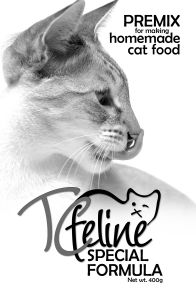 Several methods of cooking meat for making cat food are outlined below, but by far the easiest is to steam-cook meat in the stove top vegetable steamer pot. It is easy, and quick and gentle on nutrients. Steam-cook whole pieces of fresh skinless, boneless chicken thighs, or pieces of red meats, or ground meat. It only takes about 15-20 minutes to reach an internal temperature of 74 C or 165 F degrees. Or steam-cook from frozen without the need to thaw the meat first.
Several methods of cooking meat for making cat food are outlined below, but by far the easiest is to steam-cook meat in the stove top vegetable steamer pot. It is easy, and quick and gentle on nutrients. Steam-cook whole pieces of fresh skinless, boneless chicken thighs, or pieces of red meats, or ground meat. It only takes about 15-20 minutes to reach an internal temperature of 74 C or 165 F degrees. Or steam-cook from frozen without the need to thaw the meat first.
Cat food prepared with cooked meat does not freeze and thaw as well as raw meat cat food. It may be best to cut the described recipes in half and keep the food refrigerated for the 4-5 days it takes to be eaten instead of freezing the food.
For cats who refuse stale foods, similar to cats not eating day-old canned food, the meat may have to be cooked on demand. 90 gram portions of raw meat can be stored frozen, cooked on demand in the microwave or vegetable steamer, and a 2 gram portion of the premix sprinkled over it, or meat can be canned in the smallest available jars and then top dressed with premix just before serving.
The following recipes are prepared using TCfeline Special Formula. TCfeline Special Formula contains all B vitamins in supplement form and does not rely on addition of liver to supply B vitamins from food source, making it uniquely suitable for use with cooked meats. TCfeline Special Formula is a premix formulated for adult cats. If you are using cooked meats for kittens or pregnant or lactating cats, please scroll towards the bottom of this page for a recipe using TCfeline Original -the premix higher in Phosphorus and Calcium to meet the mineral needs of growing kittens and moms.
Cooking meat in a stove top vegetable steamer pot
This is the easiest and fastest and possibly the best way to cook meats for cat food. Put 5 cm or 2 inches of water into bottom pot. Bring to a boil. Stack the top steamer pot (with the holes) onto the bottom pot and place meat inside. Cover with lid. Fresh meats like whole skinless, boneless chicken thighs or ground meat cook in 15-20 minutes. Cooking meats from frozen takes about 30 minutes, depending on thickness. Use a food thermometer to check internal temperature.
Allow meats to cool before proceeding with the recipe. Pieces of meat will need to be cut into small pieces or shredded or take a quick spin in a food processor.
- RECIPE :
- 900 g fresh boneless meat, ground, in cubes, or pieces
Cook in vegetable steamer pot. Allow to cool. Shred, puree, or cut pieces as necessary. Add:
- 1/2 cup – 1 cup water for desired texture.
- 20 g TCfeline Special Formula, sprinkled evenly over the meat. Blend in evenly.
Optional addition:
- 2 raw egg yolks. Egg yolk creates a smooth texture many cats like, and adds flavour many cats like.
- OR add 1/4 cup (20 g) pulverized freeze dried liver for taste.
- OR top dress meal with a sprinkle of Nutritional Yeast.
Yields 9 portions of approximately 130 g each (= 9 days of food). Divide into daily portions and freeze for storage. Thaw individual portion before feeding. Many cats prefer to eat this warmed up.
- HALF RECIPE:
- 450 g meat cooked in the vegetable steamer, shredded, pureed or cut into small pieces.
- 1/4 cup – 1/2 cup water for desired texture.
- 10 g TCfeline Special Formula, sprinkled evenly over the meat, Blend in evenly.
Optional addition:
- 1 raw egg yolk. Egg yolk creates a smooth texture many cats like, and adds flavour many cats like.
- OR add 2 tablespoons (10 g) pulverized freeze dried liver for taste.
- OR top dress meal with a sprinkle of Nutritional Yeast.
Yields 4-5 days of food and does not have to be frozen. Store in the refrigerator. Many cats prefer to eat this warmed up.
Buying cooked meat
Cats are incredibly fond of those little rotisserie BBQ chickens from the deli department at the grocery store. Buy them hot or cold, remove the skin and bones and cut into little bits. Sometimes, cooked pulled chicken is also available in the deli department. This kind of meat will have lost some moisture during the dry heat cooking method, and less meat is used in the recipe.
- RECIPE :
- 840 g cooked meat stripped from a rotisserie style chicken, shredded or cut into tiny cubes
- 20 g TCfeline Special Formula, sprinkled evenly over the meat
- 1/2 cup – 1 cup water for desired texture. Blend all ingredients evenly.
Optional addition:
- 2 raw egg yolks. Egg yolk creates a smooth texture many cats like, and adds flavour many cats like.
- OR add 1/4 cup (20 g) pulverized freeze dried liver for taste.
- OR top dress meal with a sprinkle of Nutritional Yeast.
Yields 9 portions of approximately 130 g each (= 9 days of food). Divide into daily portions and freeze for storage. Thaw individual portion before feeding. Many cats prefer to eat this warmed up.
- HALF RECIPE:
- 420 g cooked meat stripped from a rotisserie style chicken, shredded or cut into tiny cubes
- 10 g TCfeline Special Formula, sprinkled evenly over the meat
- 1/4 cup – 1/2 cup water for desired texture. Blend all ingredients evenly.
Optional addition:
- 1 raw egg yolk. Egg yolk creates a smooth texture many cats like, and adds flavour many cats like.
- OR add 2 tablespoons (10 g) pulverized freeze dried liver for taste.
- OR top dress meal with a sprinkle of Nutritional Yeast.
Yields 4-5 days of food and does not have to be frozen. Store in the refrigerator. Many cats prefer to eat this warmed up.
Cooking a roasting chicken yourself
It is easy enough to put a raw roasting chicken in the oven at home. Place the whole chicken in a casserole dish with lid. Do not add anything. Water is not required. The chicken will release its own juice during cooking, which can be blended back into the meat after deboning. The skin can stay on, but should be removed during deboning. 1-1/2 hours at 300F makes for fall-off-the-bone meat. You can also put the chicken in a plug-in slow cooker or crock pot.
- RECIPE :
- 840 g cooked meat stripped from a home-roasted chicken, shredded or cut into tiny cubes
- 20 g TCfeline Special Formula, sprinkled evenly over the meat
- 1/2 cup – 1 cup juice from the chicken for desired texture. Blend all ingredients evenly.
Optional addition:
- 2 raw egg yolks. Egg yolk creates a smooth texture many cats like, and adds flavour many cats like.
- OR add 1/4 cup (20 g) pulverized freeze dried liver for taste.
- OR top dress meal with a sprinkle of Nutritional Yeast.
Yields 9 portions of approximately 130 g each (= 9 days of food). Divide into daily portions and freeze for storage. Thaw individual portion before feeding. Many cats prefer to eat this warmed up.
- HALF RECIPE:
- 420 g cooked meat stripped from a home-roasted chicken, shredded or cut into tiny cubes
- 10 g TCfeline Special Formula, sprinkled evenly over the meat
- 1/4 cup – 1/2 cup juice from the chicken for desired texture. Blend all ingredients evenly.
Optional addition:
- 1 raw egg yolk. Egg yolk creates a smooth texture many cats like, and adds flavour many cats like.
- OR add 2 tablespoons (10 g) pulverized freeze dried liver for taste.
- OR top dress meal with a sprinkle of Nutritional Yeast.
Yields 4-5 days of food and does not have to be frozen. Store in the refrigerator. Many cats prefer to eat this warmed up.
Pressure canning meat
Want to create meat that smells just like canned cat food? In that case, a pressure cooker is the thing to get. It is a bit intimidating at first, but a great tool for putting a generous supply of ready-to-eat meats into the pantry that doesn’t require refrigeration for storage. This method is my personal favorite, because the cats consistently like this and it also allows for an emergency supply of cat food. This method is also the best when the food needs to be pureed to pass through a syringe for assist feeding or tube feeding. Meat can be canned ground (my favorite), in cubes, or even big pieces including bones like chicken thighs. However, I would recommend removing excessive amounts a fat and skin off poultry, because it will make the juice too fatty – which many cats object to. Just pack the jars with meat. Do not add anything. Water is not required. The meat will release its own juice during cooking. Canning also allows for preparing portioned-sized quantities of meat by using the smallest sized canning jars.
⇒ There are no safe options for canning ANY meats in a boiling water canner. You must use a pressure canner. Please familiarize yourself with the use of a pressure canner before proceeding. Also, salt is added to to canned foods for humans as flavor only. It is not added as a preservative. Do not add salt when canning meat for cats.
Step-by-step instructions for canning ground meat or meat chunks using a pressure canner and the “raw pack” method:
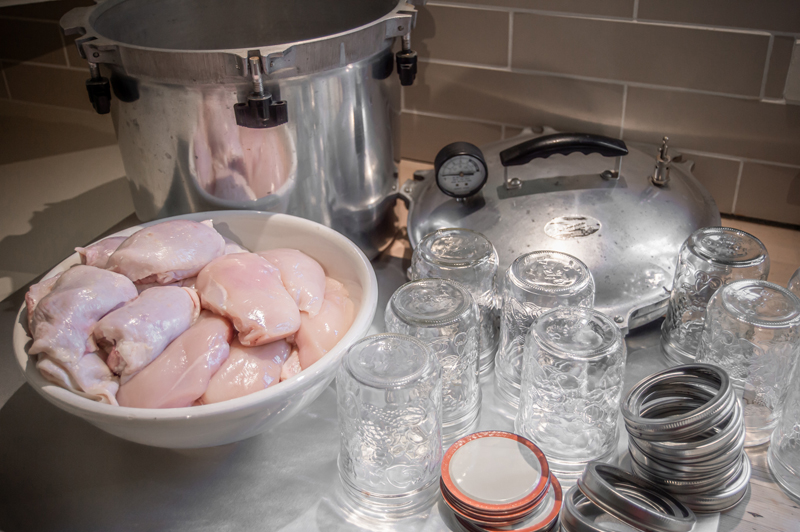
STEP 1- Use 125 ml (4oz), 250ml (8oz.) or 500ml (pint) canning jars. Do NOT use bigger jars. Wash jars, bands, and lids in hot, soapy water. Rinse well. Or run your jars through the hot cycle in your dishwasher.
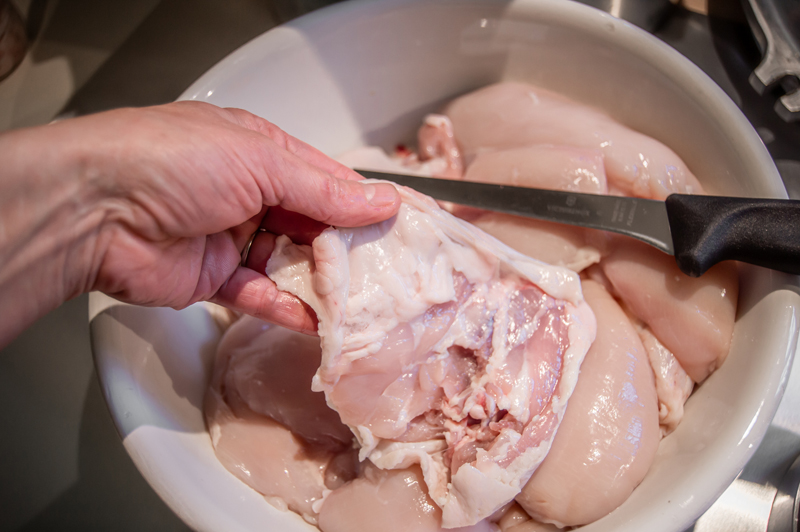
STEP 2 – Have plain meat in whole pieces or ground or chunked ready. Remove skin and excess fat. Small poultry can be canned with bones for ease, but remember to discard bones before using the canned meat in cat food. Cooked bones are not safe for cats.
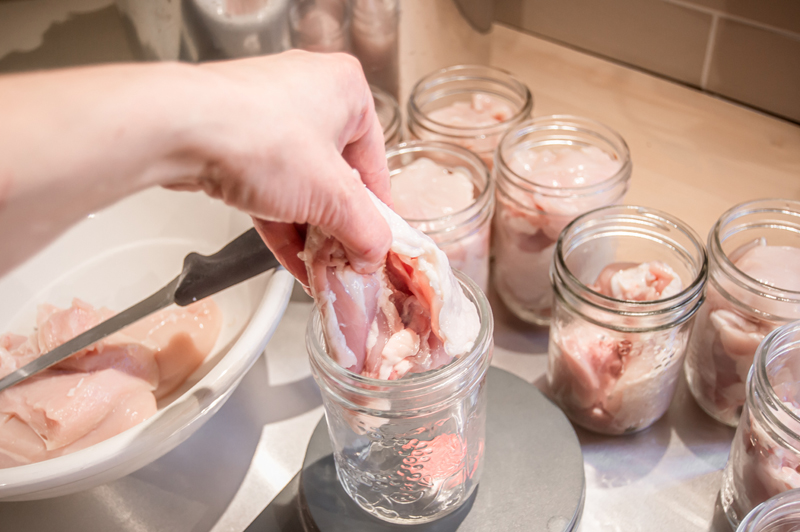
STEP 3 – Pack meat cold into jars. Do not add anything. Water is not required. Avoid leaving air pockets as best as possible. Leave 1 inch (3 cm) space at top.
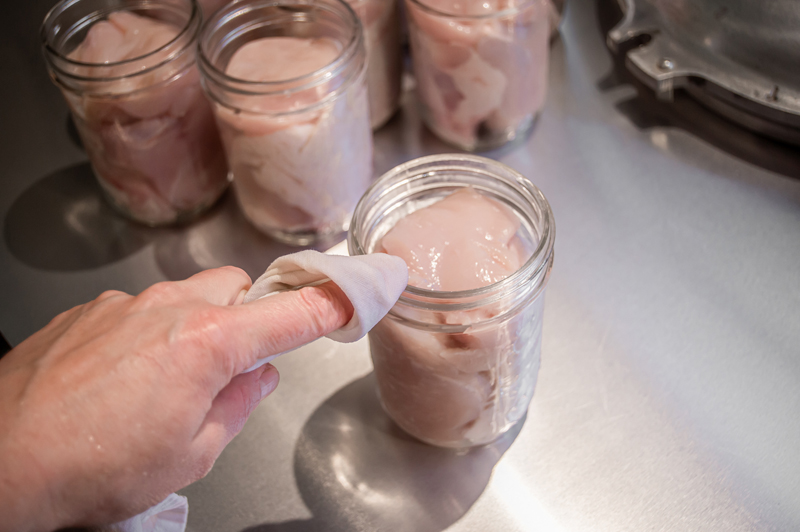
STEP 4 – Wipe rim of jars with clean cloth. Slightly moist cloth works best. Meat residue left on rim will inhibit proper seal of lid.
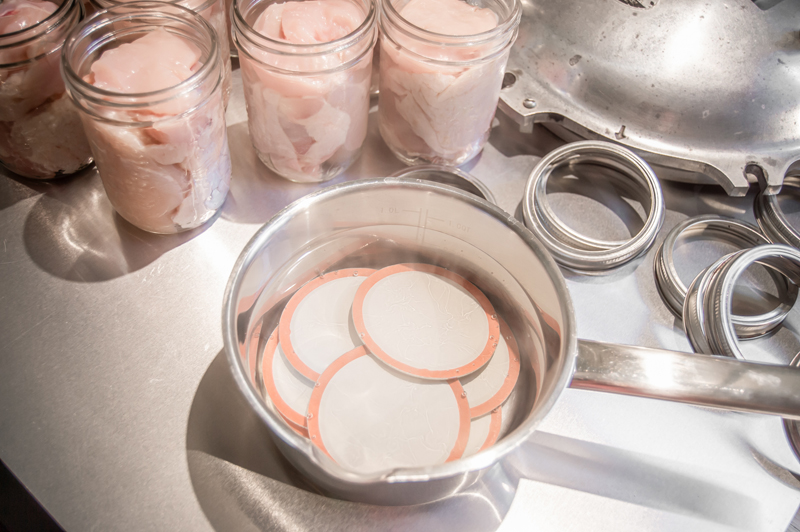
STEP 5 – Place lids in saucepan; cover with hot water. Heat to barely simmer over low heat to soften rubber seal. Keep warm. Do not boil.
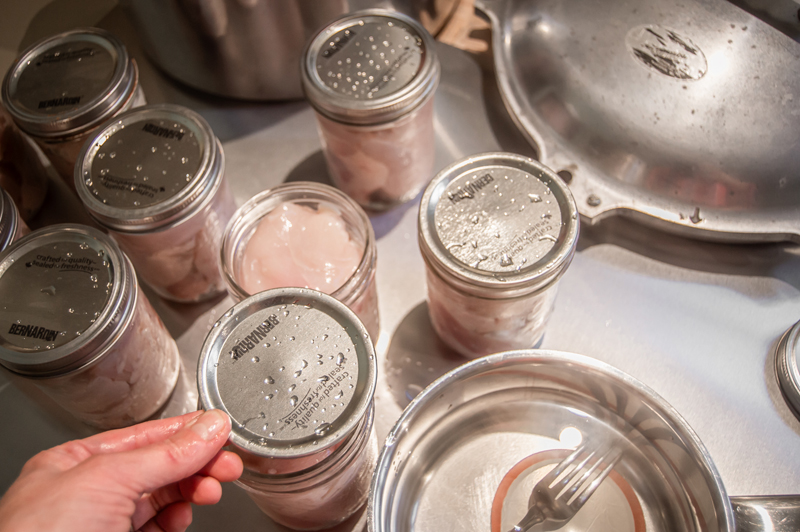
STEP 6 – Place warm lids on jars and tighten band one jar at the time. Tighten bands “finger tight”. Do not over tighten.
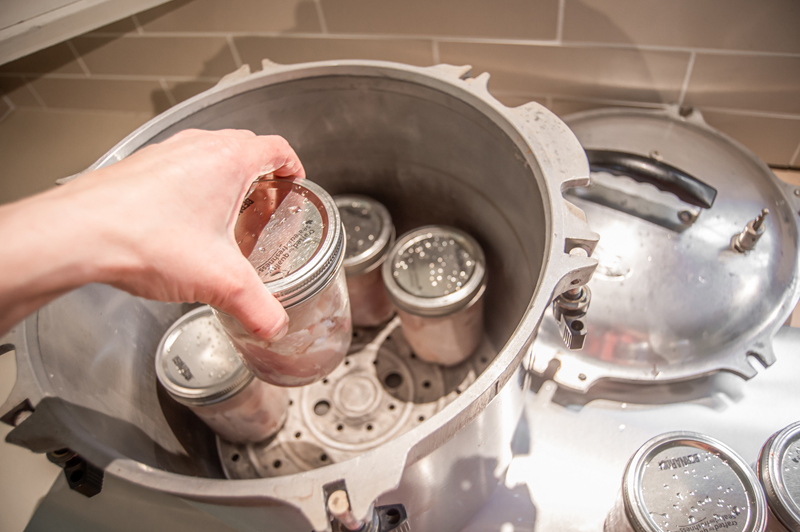
STEP 7 – Place sealed jars on trivet in pressure canner. Follow manufacturer’s directions for number of jars and amount of water to add to canner. In our pressure canner, I can fit 24 x 250 ml jars on 2 levels.
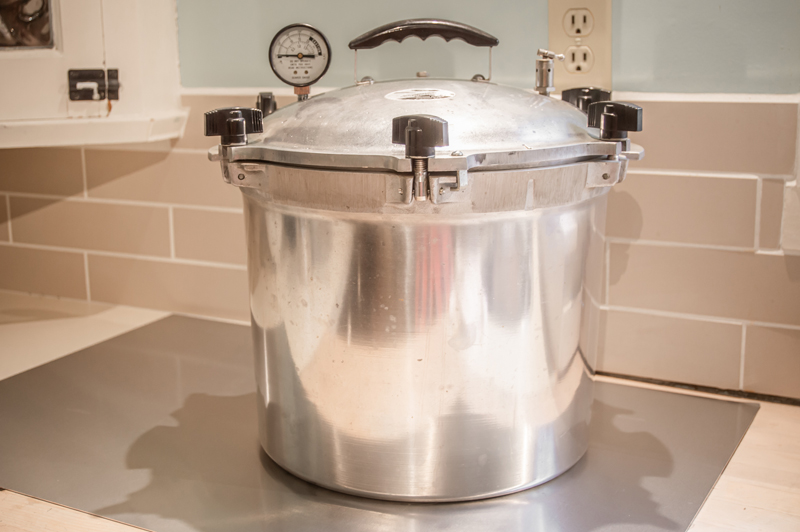
STEP 8 – Seal pressure canner and heat until 11 lb. pressure is reached, then begin timing. Process for 1 ¼ hours (75 min.) at recommended pressure. See chart below for specific pressure recommendations based on your altitude. Processing time remains the same. 0 – 2,000 ft …11 lb. 2,001 – 4,000 ft. …12 lb. 6,001 – 8,000 ft …13 lb. 6,001 – 8,000 ft …14 lb.
STEP 8 – Seal pressure canner and heat until 11 lb. pressure is reached, then begin timing. Process for 1 ¼ hours (75 min.) at recommended pressure. See chart below for specific pressure recommendations based on your altitude. Processing time remains the same.
0 – 2,000 ft. ……………..11 lb.
2,001 – 4,000 ft. ……….12 lb.
6,001 – 8,000 ft. ……….13 lb.
6,001 – 8,000 ft. ……….14 lb.
STEP 9 – When processing time is up, turn stove off and allow pressure in the canner to drop naturally (or leave until next day). When pressure has dropped completely, open cooker and remove jars. Place in a draft-free place for 12 hours. Do not tip jars. Check every jar to make sure lid has sealed properly. When sealed properly the lid will be concave and will not give or make popping sound if pushed on. Refrigerate any jars that have not sealed properly and use within 3 days.
The juice from the meat will separate during canning and the whole thing will end up looking like meat in broth. Before using the meat in the following recipe, stir the meat and juice back together. The meat is very soft. Just the stirring the juice back into the meat will often break up any pieces sufficiently for eating, making further shredding or cutting unnecessary.
-
-
- HALF RECIPE:
- 450 g canned meat with juice.
- 10 g TCfeline Special Formula, sprinkled evenly over the meat. Blend thoroughly.
-
Optional addition:
-
-
- 1 raw egg yolk. Egg yolk creates a smooth texture many cats like, and adds flavour many cats like.
- OR add 2 tablespoons (10 g) pulverized freeze dried liver for taste.
- OR top dress meal with a sprinkle of Nutritional Yeast.
-
Yields 4-5 days of food and does not have to be frozen. Store in the refrigerator. Many cats prefer to eat this warmed up.
Still working on and coming soon: Cooked meat recipe for kittens
Still working on and coming soon: Raw egg yolk in cat food made with cooked meat
Still working on and coming soon: Assist feeding and tube feeding

